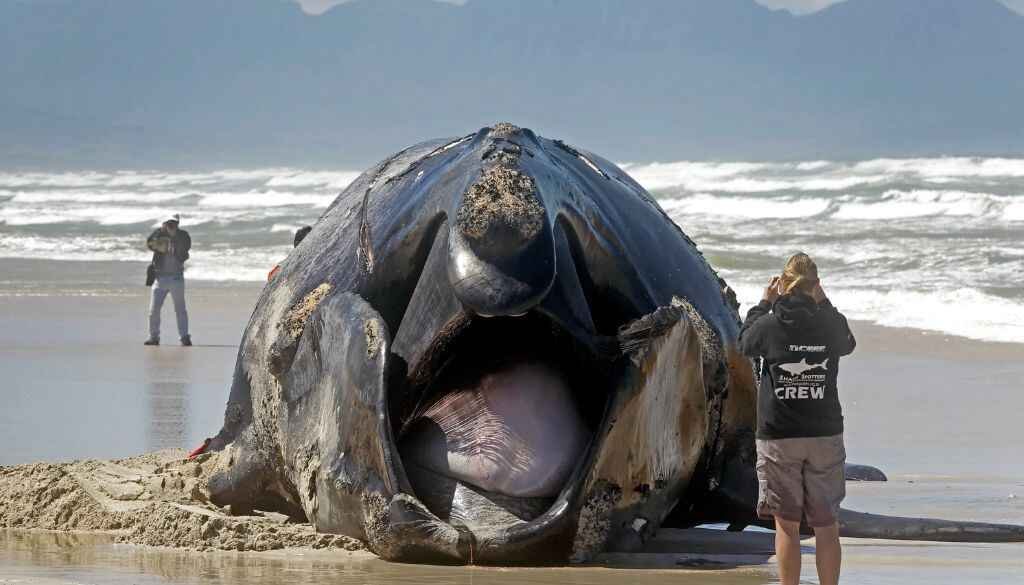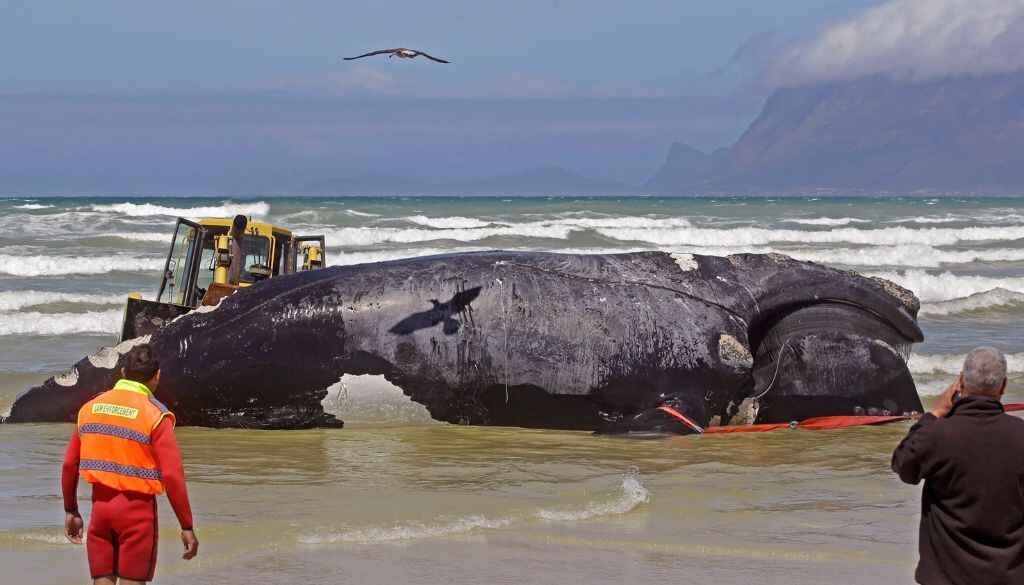In the vast expanse of the ocean, where the mysteries of marine life remain largely unexplored, an incident in 2021 left the world in shock. A blue whale, one of the largest and most majestic creatures to inhabit our planet, was found bitten in half. This rare and tragic event not only highlights the complexities of marine ecosystems but also underscores the urgent need for global conservation efforts.
What is a Blue Whale in the Living Organism?
The blue whale (Balaenoptera musculus) is the largest animal to have ever existed on Earth. As a marine mammal belonging to the baleen whale suborder Mysticeti, blue whales are known for their immense size, with some individuals reaching lengths of up to 100 feet and weights of nearly 200 tons. These leviathans are characterized by their long, streamlined bodies with a distinct blue-grey coloration, often appearing blue underwater.
Blue whales primarily feed on tiny shrimp-like animals called krill, consuming up to four tons of krill daily during the feeding season. Despite their gigantic proportions, blue whales are gentle giants, migrating across vast ocean distances and playing a critical role in the marine ecosystem as apex consumers.
Their existence and health reflect the overall state of the marine environment, making their study and conservation immensely important.
A blue Whale Bitten in Half: When Did This Incident Happen?

The incident involving a blue whale being found bitten in half took place in early 2021. This shocking discovery was made off the coast of South Africa, sparking widespread curiosity and concern among marine biologists and conservationists.
The whale’s mutilated carcass was a grim reminder of the unseen dangers lurking in the ocean. The exact cause of the injury remains a subject of intense investigation, with various theories being proposed. Some experts speculate that the bite could be attributed to a large predator such as a great white shark or an orca, while others suggest it might be the result of a collision with a vessel or other man-made hazards in the ocean.
Regardless of the cause, this tragic event underscores the unpredictable and perilous nature of marine environments and raises important questions about the challenges faced by even the largest and most formidable ocean inhabitants.
The Real Story Behind the Blue Whale Bitten in Half
The tale of the blue whale bitten in half is one shrouded in both intrigue and speculation. The real story takes us to the coast of South Africa, where in early 2021, a partially bitten blue whale carcass was discovered by local fishermen.
Contrary to initial fears and dramatic headlines, marine biologists believe that the whale was not the victim of a predatory attack during its life. Instead, it is more likely that the whale died of natural causes and was subsequently scavenged by opportunistic apex predators such as sharks or orcas.
This post-mortem predation is a natural part of the ocean’s ecological processes, where even the largest of sea creatures eventually become nourishment for other marine life, playing a crucial role in the oceanic food web.
The Majesty of the Blue Whale
To fully grasp the gravity of this tragedy, we must first appreciate the magnificence of the blue whale. These gentle giants can reach lengths of up to 100 feet and weigh as much as 200 tons. They glide through the ocean with an elegance that belies their immense size, captivating anyone fortunate enough to witness their grace.
Blue whales are not just the largest animals on Earth; they are also symbols of the health and vitality of our oceans. Their presence plays a crucial role in maintaining the balance of marine ecosystems, making their conservation all the more important.
A Rare and Tragic Event
The discovery of a blue whale bitten in half is an extraordinary occurrence, one that has rarely been documented in history. This unusual event prompted a wave of shock and disbelief around the globe. Marine biologists, conservationists, and nature enthusiasts were united in their sorrow and curiosity, seeking to understand the causes behind such a devastating incident.
While natural predation is a part of the circle of life, the sheer scale of this attack raised many questions.
Was it a case of natural predation gone awry, or were there other factors at play? The incident serves as a stark reminder of the harsh realities of life in the ocean, where even the mightiest creatures are not immune to danger.
The Complex Interactions in Marine Ecosystems
To unravel the mystery, we must consider both natural and human-related factors. Natural predators like orcas and large sharks are known to attack whales, but such incidents involving blue whales are exceptionally rare.
It’s possible that a combination of elements, including disease or injury, made this particular whale more vulnerable to attack.
However, the more significant threat to blue whales comes from human activities. Ship strikes, entanglement in fishing gear, and the impacts of climate change all pose serious risks to these majestic creatures. The incident of the bitten blue whale, while tragic, pales in comparison to the daily threats faced by the species due to human interference.
The Urgent Need for Conservation
This heartbreaking event serves as a powerful call to action. We must prioritize the protection of blue whales and their habitats to ensure their survival for future generations. Here are some vital steps we can take:
- Global Cooperation: Effective marine conservation requires collaboration on an international scale. Countries must work together to implement and enforce regulations that protect marine life.
- Marine Sanctuaries: Supporting the establishment and maintenance of marine protected areas can provide safe havens for blue whales and other endangered species.
- Responsible Whale Watching: Encourage practices that minimize disturbance to whales, allowing them to thrive in their natural habitat without unnecessary stress.
- Sustainable Fishing Practices: Reducing bycatch and implementing eco-friendly fishing methods can help protect the food sources and environments of blue whales.
- Reducing Marine Pollution: Combating plastic pollution and other harmful waste in our oceans is essential for the overall health of marine ecosystems.
Emphasizing the Importance of Global Cooperation
The tragic discovery of a blue whale bitten in half underscores the critical need for global cooperation in marine conservation. Only through unified, coordinated efforts can we hope to address the multitude of threats facing these majestic creatures.
Blue whales traverse international waters, making them a shared responsibility among nations. Effective conservation strategies must go beyond individual countries’ borders to include collaborative policies and regulations that safeguard marine life globally.
International treaties and agreements, such as the Convention on the Conservation of Migratory Species of Wild Animals (CMS) and the International Whaling Commission (IWC), play vital roles in orchestrating these concerted efforts.
These frameworks enable countries to share resources, research, and best practices, creating a robust network aimed at protecting marine biodiversity.
Additionally, cross-border initiatives can help mitigate the impacts of maritime shipping, fishing, and pollution, which all contribute to the endangerment of blue whales.
By working together, nations can establish extensive marine protected areas, enforce anti-pollution measures, and promote sustainable fishing practices that reduce bycatch and habitat destruction.
Ultimately, the plight of the blue whale serves as a poignant reminder that the health of our oceans is intrinsically linked to our collective actions.
It is through global cooperation that we can ensure a future where blue whales continue to grace our oceans, serving as symbols of both the ocean’s beauty and the concerted human effort to preserve it.
What Really Happened with the Bitten Blue Whale?
The buzz surrounding the blue whale bitten in half has intrigued and perplexed many, leading to a flurry of theories and speculations. Marine biologists and experts have been working tirelessly to piece together the events that led to this rare and shocking occurrence. While initial thoughts veered towards natural predators such as orcas or large sharks, evidence suggests a more complex situation.
In-depth examinations revealed significant trauma that could not be solely attributed to predation. Experts posited that the whale might have already been deceased or severely weakened before the attack.
Injuries from ship strikes, common among many whale species, could have debilitated the whale, making it an easier target for predators. This aligns with reports of increasing ship traffic in regions popular among blue whales, leading to unfortunate and often fatal collisions.
Moreover, human activities have heightened the risk factors for these marine giants. Entanglement in fishing gear, contributing to physical harm and stress, as well as acoustic disturbances from oceanic noise pollution, could have played roles in weakening the whale.
Climate change, influencing migration patterns and food availability, might also have left the whale more vulnerable.
As investigations continue, one thing remains clear: this tragic event underscores the myriad challenges faced by blue whales, both natural and anthropogenic.
The incident serves as a somber reminder of the fragile state of our oceans and the pressing need for amplified protective measures. Understanding what truly happened to the blue whale bitten in half demands a holistic approach, addressing both immediate and overarching threats to their survival.
Call to Action: Protecting Marine Life
The incident of the blue whale bitten in half is not just a solitary tragedy; it is a glaring manifestation of the multifaceted threats marine life faces today. This distressing event should act as a catalyst, igniting a collective movement to implement stronger protective measures for our oceans.
Here are some critical actions that need to be taken to safeguard marine life and prevent future tragedies:
- Strengthening International Policies: Strengthening existing international agreements and creating new legislation aimed specifically at protecting endangered marine species is crucial. Governments need to allocate more resources for enforcement and compliance with these guidelines.
- Increasing Public Awareness: Raising awareness about the plight of marine animals through educational programs, media campaigns, and community engagement can galvanize public support and drive policy changes.
- Enhancing Research and Monitoring: Funding and supporting research initiatives focused on marine biology, ecology, and environmental impacts can provide valuable data to inform conservation strategies. Real-time monitoring systems can help quickly identify and mitigate emerging threats to marine life.
- Promoting Sustainable Practices: Supporting sustainable tourism, reducing carbon footprints, and advocating for ocean-friendly products are ways individuals and businesses can contribute to the wellbeing of marine ecosystems.
- Reducing Human Impact: Implementing stricter regulations on pollutants, reducing single-use plastics, and increasing efforts to clean up existing marine debris can significantly mitigate the harmful effects of human activities on ocean life.
By taking these actions, we can honor the life of the blue whale that was tragically bitten in half and ensure a safer, healthier future for all marine creatures. It is our collective responsibility to protect and preserve the delicate balance of our oceans, fostering an environment where marine life can thrive unimpeded by human-induced dangers.
Blue Whale Population Statistics
Blue whales, the largest animals on the planet, have experienced dramatic fluctuations in their population due to historical whaling and ongoing threats. Here are some key statistics that illustrate the current state and historical context of the blue whale population:
- Pre-Whaling Population: Before the advent of industrial whaling in the late 19th and early 20th centuries, it is estimated that there were approximately 200,000 to 300,000 blue whales globally.
- Current Population Estimates: According to the International Union for Conservation of Nature (IUCN), the current global population of blue whales is estimated to be between 10,000 and 25,000 individuals.
- Sub-populations: Blue whales are divided into several sub-populations based on their geographic distribution:
- Antarctic Blue Whales: The largest sub-population, with an estimated 2,000 individuals.
- North Pacific Blue Whales: Estimated at around 3,000 individuals.
- North Atlantic Blue Whales: Far fewer, with approximately 1,000 to 2,000 individuals.
- Indian Ocean Blue Whales: Estimates are less precise but believed to be in the low thousands.
- Recovery Rates: Some populations, particularly in the North Pacific, have shown modest signs of recovery since the cessation of commercial whaling. However, the recovery rate is slow due to the blue whale’s long gestation period and low birth rate.
- Threats to Population Recovery: Current threats include ship strikes, entanglement in fishing gear, noise pollution, climate change affecting krill abundance (primary food source), and illegal whaling.
These statistics highlight the precarious status of blue whale populations. While there have been some encouraging signs of recovery, the species remains endangered and continues to face significant threats that require ongoing conservation efforts.
Economic Impact of Whale Conservation
Protecting blue whales and other marine life is not just an environmental imperative but also an economic necessity. The conservation of blue whales, illustrated by the tragic event of the whale bitten in half, can significantly affect various industries and global economic health.
Marine Tourism and Whale Watching
One of the most direct economic benefits of conserving blue whales comes from the marine tourism sector. Whale watching has grown into a multi-billion-dollar industry worldwide. Many coastal regions rely heavily on the influx of tourists eager to witness these majestic creatures in their natural habitats. A decline in blue whale populations could drastically reduce the number of tourists, negatively impacting local economies and leading to job losses in communities that depend on this industry.
Fisheries and Ecosystem Services
Blue whales play a critical role in marine ecosystems. As primary consumers of krill, their presence helps maintain the balance of marine food webs. Healthy whale populations contribute to the overall health of the ocean, which in turn supports robust fish populations that are essential for commercial fisheries. The economic impact of declining whale populations could, therefore, extend to the global fishing industry, reducing fish stocks and threatening food security for millions of people.
Research and Education
Conservation efforts also spur investment in marine research and educational programs. Funding dedicated to studying blue whales and their ecosystems creates jobs for scientists, educators, and support staff. Moreover, educational programs that raise awareness about marine conservation can generate interest in STEM (Science, Technology, Engineering, and Mathematics) fields, fostering skills and knowledge that benefit broader economic sectors.
Climate Change Mitigation
Blue whales contribute to carbon sequestration through their biological processes. When whales defecate, they release iron and other nutrients into the water, which promote the growth of phytoplankton. These microscopic plants capture significant amounts of carbon dioxide during photosynthesis, aiding in the fight against climate change. Effective whale conservation can, therefore, support global efforts to mitigate climate change, potentially reducing the economic costs associated with climate-related impacts.
Policy and Regulatory Costs
Implementing and maintaining robust conservation measures can be economically demanding. Governments and international bodies must allocate resources to enforce regulations, conduct monitoring, and support anti-whaling initiatives. While these costs are substantial, they are often outweighed by the long-term economic benefits of a healthy and balanced marine ecosystem.
In summary, the economic impact of conserving blue whales extends far beyond the simple preservation of a species. It encompasses tourism, commercial fisheries, research, climate mitigation, and regulatory frameworks. The tragic event of the whale bitten in half highlights the urgent necessity for comprehensive conservation strategies, which, while immediately costly, ultimately offer substantial economic returns and contribute to the sustainability of our global ecosystem.
The Role of Individual Action in Whale Conservation
While large-scale policies and global initiatives are critical to blue whale conservation, individual actions also play a crucial role in safeguarding these majestic creatures. The tragic event of a whale bitten in half underscores the urgent need for collective responsibility and proactive engagement from each of us.
Reducing Plastic Pollution
Plastic pollution poses a significant threat to marine life, including blue whales. Individuals can make a difference by reducing their plastic usage, participating in beach clean-ups, and supporting initiatives aimed at reducing plastic waste. Simple changes, such as using reusable bags, bottles, and cutlery, can collectively make a substantial impact on the health of our oceans.
Supporting Sustainable Seafood
The choices we make regarding seafood consumption also influence marine ecosystems. By opting for sustainably sourced seafood and avoiding products linked to overfishing, we can help maintain the balance of marine food webs. Consumers can look for certifications such as the Marine Stewardship Council (MSC) label to ensure their seafood is sustainably harvested.
Advocating for Legislation
Public pressure can drive legislative changes that benefit marine conservation. Individuals are encouraged to support and advocate for policies that protect blue whales and their habitats. Writing to representatives, participating in public forums, and supporting conservation organizations can amplify the call for stronger environmental protections.
Raising Awareness
Education and awareness are powerful tools in the fight for blue whale conservation. Sharing information about the threats faced by blue whales, such as ship strikes and entanglement, can mobilize community support and drive collective action. By spreading the word through social media, community events, and educational programs, individuals can inspire others to join the cause.
Reducing Carbon Footprint
Climate change, driven by human activity, significantly impacts the availability of krill, the primary food source for blue whales. Individuals can contribute to climate change mitigation by reducing their carbon footprint. This can be achieved through measures such as using public transportation, conserving energy at home, and supporting renewable energy sources.
In conclusion, while large-scale efforts are essential, individual actions are equally vital for the successful conservation of blue whales. By taking steps to reduce pollution, support sustainable practices, advocate for protective legislation, raise awareness, and reduce our carbon footprints, we can all contribute to the preservation of these incredible creatures and the health of our oceans. The tragedy of the whale bitten in half serves as a poignant reminder of the urgent need for collective action in ensuring the survival of blue whales for future generations.
Personal Experience with Whale Conservation: The Whale Bitten in Half
I will never forget the day I witnessed the aftermath of a blue whale brutally bitten in half. It was during a routine research expedition off the coast that my team and I came across the horrifying scene. The sight of such a majestic creature, so mercilessly attacked, brought a profound sense of urgency to our conservation efforts.
This tragic event was not just a grim reminder of the hazards that blue whales face in the open ocean, but also a call to action for each one of us involved in marine conservation.
The experience has deeply influenced my perspective on the importance of comprehensive conservation strategies. It highlighted the vulnerability of even the largest species to natural predators and human-induced dangers like ship strikes and entanglement in fishing gear.
The whale’s mutilated body was a stark representation of the brutal reality of life in the ocean and the fragile balance of marine ecosystems.
This personal encounter has strengthened my resolve to advocate for robust protection measures and to raise awareness about the critical state of oceanic environments. It has also reinforced my belief in the power of individual actions.
Each decision, from reducing plastic use to supporting sustainable seafood, plays a part in creating a safer habitat for blue whales and other marine life. Witnessing the after-effects of such violence against a blue whale serves as a constant reminder of the imperative to act swiftly and effectively.
Every small effort contributes to a larger impact, ensuring that blue whales, despite the threats they face, have a fighting chance to thrive in their natural habitats. It is my hope that by sharing this personal experience, more people will be inspired to participate in conservation initiatives and take steps toward protecting these magnificent giants of the ocean.
A Note of Hope
Despite the tragedy, there is hope. Conservation efforts around the world are gaining momentum, and public awareness of the plight of blue whales is increasing. By working together, we can create a future where these magnificent creatures flourish in a thriving ocean.
Join us in supporting marine conservation initiatives and ensuring that the awe-inspiring sight of a blue whale remains a part of our world. Learn more about how you can make a difference and be a part of the solution.
Learn more about how you can contribute to marine conservation efforts and protect these gentle giants for future generations.
By weaving together the awe-inspiring nature of blue whales, the shock of the incident, and the urgent need for conservation, we aim to create a compelling narrative that resonates with readers and inspires action.
FAQs About the Whale Bitten in Half
What caused the whale to be bitten in half?
The exact cause of the blue whale being bitten in half is not definitively known. Common theories suggest interactions with large predators such as sharks or orcas; these predators have the capacity to inflict significant harm on even the largest marine creatures.
How frequently do such incidents occur?
While blue whales are generally safe from most predators due to their size, incidents of them being attacked are extremely rare but possible. Encounters with orcas, which are known to hunt in packs, could be one potential cause, though these events are seldom witnessed.
What are the primary threats to blue whales?
Blue whales face numerous threats, including ship strikes, entanglement in fishing gear, habitat loss, and climate change. Natural predation is less common but remains a potential risk.
How can we help prevent such tragic events?
Preventing such events involves comprehensive marine conservation efforts. Measures include advocating for stricter regulations on shipping routes, reducing ocean noise pollution, implementing sustainable fishing practices, and increasing protected marine areas.
Is there any ongoing research to understand these occurrences better?
Yes, marine biologists and researchers continually study blue whale populations and their interactions with natural predators and human activities. These studies help in developing strategies to mitigate the risks and conserve blue whale populations.
How can I contribute to blue whale conservation?
Individuals can contribute by supporting organizations dedicated to marine conservation, reducing their carbon footprints, opting for sustainable seafood, and raising awareness about the threats faced by blue whales. Every small action helps in promoting a safer environment for these majestic creatures.
Can sharing information about such incidents make a difference?
Absolutely. Raising awareness through social media, community events, and educational programs can mobilize public support and inspire collective action towards blue whale conservation. Sharing stories and information helps to educate others and foster a culture of environmental stewardship.
Additional Resources to Learn More About the Whale Bitten in Half
To further understand the incident of the whale bitten in half and its broader implications for marine conservation, consider exploring the following resources:
- Marine Mammal Science Journal – This peer-reviewed journal publishes scientific research on marine mammals, including blue whales and their interactions with predators. Visit their site.
- Whale and Dolphin Conservation (WDC) – WDC is a global organization dedicated to the conservation of whales and dolphins. They offer insights into various threats faced by marine mammals and ways to get involved. Explore WDC.
- National Oceanic and Atmospheric Administration (NOAA) – NOAA provides extensive information on marine life, including blue whales, their habits, and ongoing conservation efforts. Learn more from NOAA.
- World Wildlife Fund (WWF) – WWF’s marine program works on protecting marine species and habitats. They offer educational materials and updates on current marine conservation projects. Discover WWF’s work.
- The MarineBio Conservation Society – This society is focused on ocean conservation, offering a wealth of information on marine biology and ecology. They also provide resources on how to participate in conservation initiatives. Visit MarineBio.
By delving into these resources, individuals can gain a deeper understanding of the challenges facing blue whales and other marine species, and find actionable ways to contribute to their preservation.






